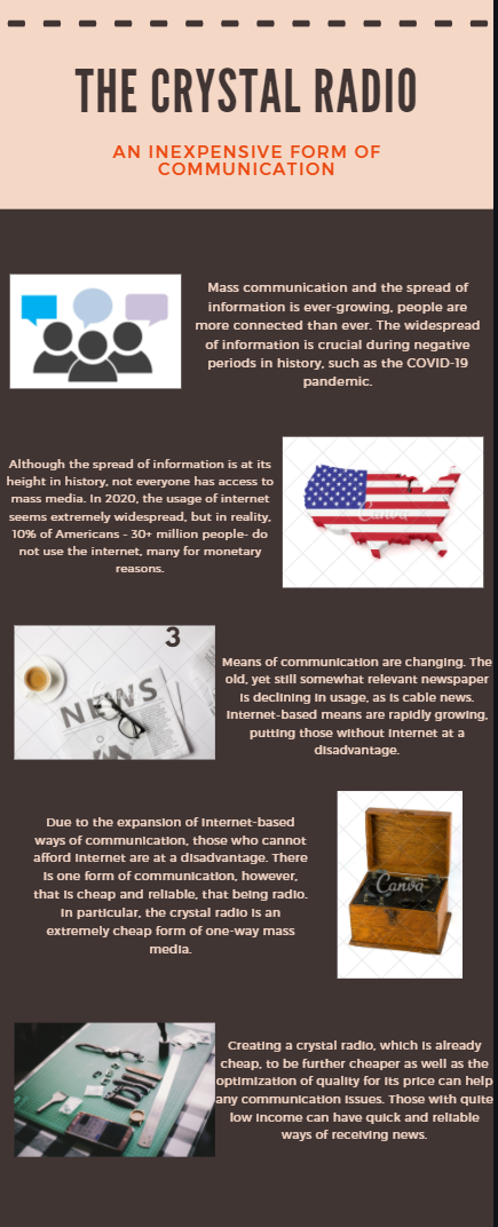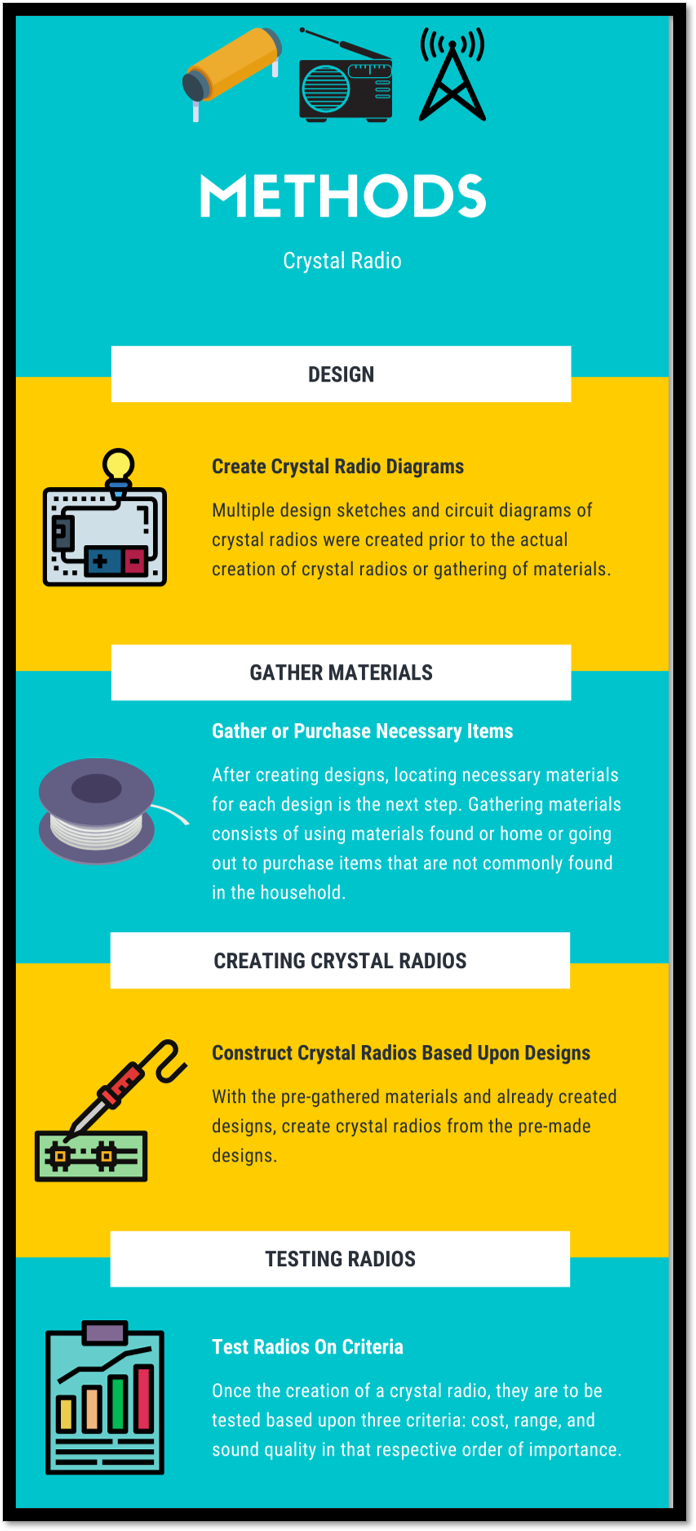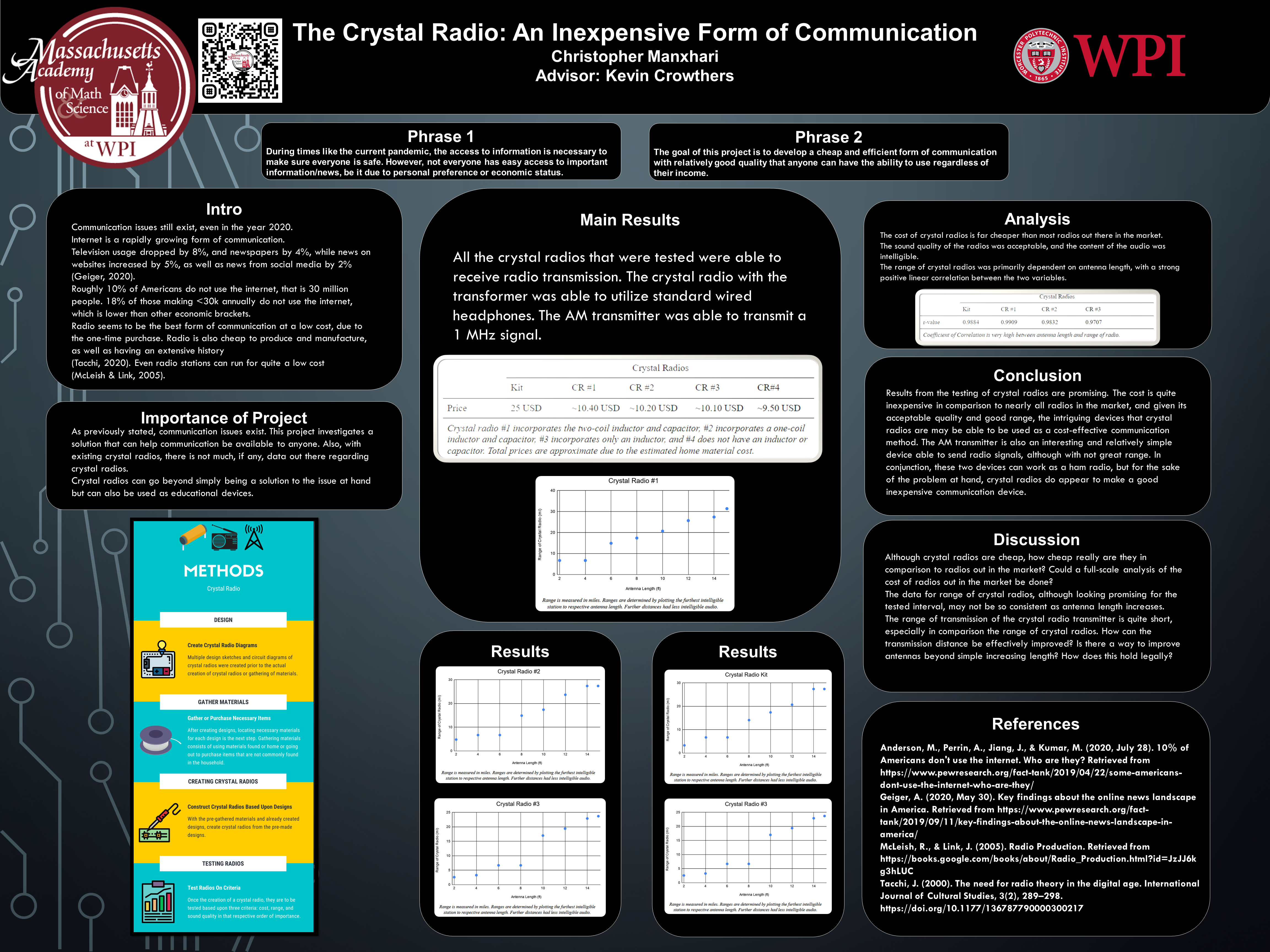STEM I
The Crystal Radio: An Inexpensive Form of Mass Communication
STEM is a class that consists of a long-term science, engineering, or mathematical project that each student must participate in.
This project starts from the beginning of the year to around mid-February, in which students present their project at a fair in February.
Abstract
During instances such as the COVID-19 pandemic, access to necessary information is crucial for safety, but not everyone has
access to information. Therefore, the goal is to develop a form of cheap and efficient communication that does not lack in quality so that anyone, regardless of
income, may have access to important information. Multiple initial sketches and crystal radios diagrams were created. Prototypes of crystal radios were constructed
upon created designs and out of both homemade and purchased materials. These prototypes were tested based upon three criteria: cost, range, and sound quality.
Furthermore, an AM transmitter and crystal radio able to use regular headphones were created. The average base crystal radio costs roughly $10, an average range of
27.4 miles to 31.4 miles using a 15-foot antenna, each with acceptable audio quality. The crystal radio design with a transformer was able to utilize standard
headphones rather than the earpiece and costs approximately $15. The range and quality was similar to the base crystal radios. The AM transmitter was able to
broadcast a 1-MHz signal and was tested on multiple radios. The transmitter costs $16 with audio quality similar to that of regular broadcasting stations.
It has an estimated range of 200 feet with a 10-foot antenna, which was not further tested due to the legality of transmitting radio signals. Crystal radios are
inexpensive devices that may be able to be used as a method of communication for those who have financial issues. Prices may be different than recorded.
During times like the current pandemic, the access to information is necessary to make sure
everyone is safe. However, not everyone has easy access to important information/news, be it due
to personal preference or economic status.
The goal of this project is to develop a cheap and efficient form of communication with relatively
good quality that anyone can have the ability to use regardless of their income

The infographic to the left lays out the basis of the project. The problem at hand pertains to communication issues,
particularly during the COVID-19 pandemic. Even though technology seems to be extremely modernized in the current year and that everyone has widepsread access to
information, particularly through the internet, it turns out that 10% of U.S. citizens do not use the internet. While this can be due to preference, further studies show
that those with lower income are less likely to use the internet, showing a financial reason to the lack of internet. While other forms of communication are out there, and
internet is not the only form, internet is undeniably a rapidly growing means of transferring information. Due to this, crystal radios, an old yet very cheap form of communication
were looked at and created in my project.
To the left is another infographic regarding my project. Particularly, this infographic focuses on the methods and materials
section of the project. Once research was completed, the first step to achieving my project was to first design and create crystal radio diagrams, both physical and circuit diagrams. Multiple
of these were created, and with that necessary materials for creating crystal radios based upon these designs were collected. The collected materials were both materials that could be found
at home and materials that needed to be purchased. Once purchased, these materials were used to create the cyrstal radios based off of previously created designs. With the creation of
crystal radios, the crystal radios were tested upon three criteria: cost, range, and sound quality, with descending importance.





Analysis
The results of the Pearson’s r test on each yield that the two variables are greatly and
positively correlated with a coefficient of correlation near 1. However, flaws exist in this testing,
due to the relatively low sample size and range, this linear correlation may not hold as the length
of antenna further increases. Beyond that, there exist a finite quantity of radio stations, meaning
that the data set of stations is discrete, whereas the length of the antenna is continuous and can be
measured. Sound quality of the crystal radios was the most difficult of the three to measure. Audio
software was used to analyze the sound, however, due to the build of the piezoelectric earpiece,
there were difficulties in properly recording the sound. How loud the actual crystal radio was
versus how loud the recording was differed quite greatly. Despite difficulties, the crystal radios
were still analyzed on sound quality. The crystal radios had quite some background noise
present, with crystal radio #1 having the least presence of background audio, then following is
the kit, then crystal radio #2, and #3 with the most background noise. The difference in
background noise among all radios was not drastic, but did exist. The amount of background
noise is comparable to that of an alarm clock with a built in radio. Direct listening of the radio
with the earpiece is acceptable, although not being to the quality of radios out there in the
market. Most stations received were intelligible and understood by the listener.
The two iterations of crystal radios were also tested. The first of which, being the crystal
radio capable of using non-piezoelectric earphones did not require much testing. This iteration
came in at a cost of roughly $15, due to the $10 transformer, but also the negation of the
piezoelectric earpiece’s cost, assuming one already has a pair of usable headphones. The
headphones used in experimentation were able to receive sound from the radio, and the sound
quality was comparable to the use of the piezoelectric earpiece. Range of the radio was
unaffected by the change.The AM transmitter was tested upon three criteria similar to the original crystal radios,
that being cost, range of transmission, and sound quality of transmission. With the cost of all
parts summed, the transmitter cost in total roughly $16, not including the price of 4 AA batteries.
This AM transmitted sent out signals at 1 MHz, and multiple AM radios, including crystal
radios. were tested to see if they were able receive the aforementioned transmitted signal. The
AM radios used in testing were able to receive the 1 MHz signal, and sound quality of the
transmission was comparable to other stations received by each radio. The distance of
transmission of the AM radio transmitter followed a correlation between the range and antenna
length similar to that of the previous crystal radios. Range of transmission, however, was
nowhere near the range received by crystal radios at tens of miles. Instead, at an antenna length
of 10 feet, the transmitter was able to send off a signal that could be received only 200 feet away.
Although increasing the antenna beyond 10 feet would likely increase transmission distance,
testing halted at a range of 200 feet, due to the legality of transmitting signals without a ham
radio license. Having an antenna as long as the one tested with the mere result of a 200 foot
transmission does not seem acceptable; ways to improve the antenna beyond simply increasing
length would have to be looked into. Below is the correlation between antenna length and
transmission distance.
Discussion/Conclusion
The testing procedure of crystal radios did have some flaws. Most of these flaws came
from the testing of range, even though there were great results showing a strong positive
correlation between antenna length and reception distance. One issue is the fact that although the
two variables tested, antenna length being independent and reception length being independent,
are continuous, there does not exist an infinite amount of radio stations, meaning that there are
intervals of distance where radio stations are not present. This partially hinders the data for
range, per se there was a radio station 20 miles away and one 30 miles away. If the antenna
length for exactly 20 miles was slightly increased, there will be no recorded difference until an
antenna length for 30+ miles is recorded. Another potential issue with the range data is that only
antenna lengths up to 15 feet, in mostly intervals of 2 feet, were recorded. The data may not
follow such a linear trend for longer antenna lengths. As for data regarding cost, home materials
were roughly estimated, although that estimation likely does not impact the results greatly.
Additionally, prices compared to radios in the market were not intensely analyzed. Regarding
audio quality, recording audio was difficult, which resulted in a quieter and not entirely accurate
recording. Additionally, the software used was not the best software for analyzing the recordings
and preferred software was not available. Some subjective testing was also used, which is not
necessarily bad, but more objective data is preferred.
Crystal radios are inexpensive communication devices, coming in at around $10 for
constructed crystal radios. Despite being cheap, they have quite the range, as well acceptable
audio quality. Although results yielded that crystal radios were not to the level of other general
radios in terms of performance, they are by far cheaper than the vast majority of radios out in the
market. For the problem at hand, crystal radios certainly appear to be an effective low-cost
solution to communication issues. Nearly every individual is financially able to afford a crystal
radio in terms of cost, and beyond that crystal radios can be constructed by anyone with the
necessary materials. The AM transmitter also allows for a radio that is able to transmit and
receive in conjunction with crystal radios, working in some ways as a ham radio. Although the
transmitter has a short range, it is interesting to see how AM signals can be transmitted at a low
cost. Looking beyond the purpose of the project, crystal radios are also able to be used as
educational devices in learning radios. Their simplicity in structure, yet complexity in how they
work make them fascinating devices.
There certainly is more to this project than what has been conducted. Something that can
be looked into in the future is how to improve the antenna, particularly for a low price. While
increasing the antenna length can increase reception, it becomes impractical to have a very long
wire. This is primarily important for the AM transmitter, as with a 10-foot antenna wire, it can
only transmit 200 ft, which may not be necessary for this project, as there are legal issues with
transmitting long distances, but it is certainly one thing that can be improved on, not only to
increase transmission/reception distances, but to also improve the sound quality. This project did
not look into comparing the prices of radios in the market to the crystal radios to an extensive
degree. A full-scale analysis of radios on the market could be an objective to further insinuate
that crystal radios are low-cost in comparison to other radios. Looking into how to make
purchased pieces from raw materials may also help decrease the price of the radio. Diodes can
be made from pencil lead and a piece of metal, such as a razer, held over a flame unil blue, but
diodes are quite cheap in the radio. The earpiece takes up about half of the price of the radio,
looking into how a makeshift piezoelectric earpiece can be made could reduce costs. Moreover,
AM data channels may be an interesting and useless advancement with crystal radios, as more
than sound can be received by the radio; however, information out there on AM data channels
seems to be limited. Although this project has established quite the amount on crystal radios and
their low-cost, much more can be done regarding the radios.
References






